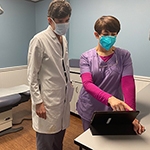
Everyone has heard of the thyroid, that butterfly shaped gland in the front of our necks, responsible for regulating metabolism in a variety of ways. Most people, however, are unaware that we also have parathyroid glands. These four tiny glands are located near the thyroid (thus the name, PARAthyroid). The parathyroid glands are responsible for regulating our bodies’ calcium metabolism.
Hyperparathyroidism
Generally, these glands do a great job of keeping our calcium levels just right. Occasionally, one or more of the parathyroid glands can become enlarged and over-active. This leads to a condition called hyperparathyroidism in which too much parathyroid hormone is produced. Hyperparathyroidism occurs in 1 in 400 women and 1 in 1000 men.
Hyperparathyroidism causes loss of calcium from the bones, resulting in osteopenia or osteoporosis, and increased risk for fractures. It can also cause a number of other issues, including:
- Bone pain
- Kidney stones
- Cardiovascular disease
- Gastrointestinal symptoms like acid reflux or constipation
- Feelings of severe fatigue
- Loss of energy
- Depression
- Anxiety
- Insomnia
- Trouble remembering things or focusing mentally (known as “brain fog”)
Hyperparathyroidism Diagnosis and Surgical Treatment
Hyperparathyroidism is confirmed by checking levels of calcium and parathyroid hormone in the blood, and calcium in the urine. Vitamin D levels, which are important in calcium metabolism, are also checked.
Fortunately, hyperparathyroidism can be treated, and usually cured, with a minimally invasive surgery known as a parathyroidectomy. If surgery is planned, imaging studies to help identify the location of the abnormal parathyroid gland(s) are performed, including ultrasound and a nuclear medicine scan. A CT scan may also be done. Normal parathyroid glands cannot be seen on imaging studies because they are too small (about the size of a grain of rice), but enlarged, overactive glands can often be seen.
Surgery is performed in the operating room under anesthesia. It is usually a day-surgery, with patients returning home shortly after the operation. Through a small (about 1 inch long) incision on the lower neck, the surgeon searches for and removes the abnormal gland (or glands).
At Austin Surgeons, we use a technique called “radio-guided surgery” to help identify the abnormal gland. A compound called “sestamibi” is administered through an IV and concentrates in the abnormal parathyroid gland. The surgeon uses a device called a gamma-probe to help locate the abnormal gland containing the sestamibi.
During surgery, we monitor the patient’s parathyroid hormone level. Parathyroid hormone has a very short half-life in blood, and once the abnormal gland or glands have been removed, the parathyroid hormone level drops very quickly, usually within 5 or 10 minutes. This helps confirm that the abnormal gland(s) have been removed.
After a short time in the recovery room, the patient can return home. We encourage getting up and around as soon as possible but avoiding vigorous physical exertion for about 2 weeks. The incision is usually a bit sore, but not terribly painful. Often, over-the-counter pain medications like Tylenol and Advil are all that is needed. A bit of swelling along the incision is normal and will resolve with time. The scar typically heals very well.
Parathyroidectomy has a high rate of success in curing hyperparathyroidism. As a result, most patients experience decreased bone loss, fewer kidney stones, and often improvement in symptoms such as bone pain, fatigue and “brain fog”. As with any surgery, there are risks and there can be complications, but these are uncommon.
Parathyroidectomy in Austin
Because these tiny parathyroid glands can be difficult to find, and their abnormalities can be subtle, having an experienced and skilled surgeon is critical. At Austin Surgeons, we have the experience and skill you are seeking. If you have hyperparathyroidism, schedule a consultation with one of our board-certified general surgeons today. During your visit, we will thoroughly review the details of your case, discuss your treatment options, and carefully explain the risks of surgery and your anticipated recovery. We look forward to helping you through a successful surgery.
For more information about hyperparathyroidism surgery, visit austinsurgeons.net or call (512) 467-7151.
For the latest Austin Surgeons news, follow us on Facebook and Instagram.

